![]()
![]()
![]()
Use LEFT and RIGHT arrow keys to navigate between flashcards;
Use UP and DOWN arrow keys to flip the card;
H to show hint;
A reads text to speech;
55 Cards in this Set
- Front
- Back
|
What is pharmacology?
|
Study of drugs and the study of the effects of drugs |
|
|
A ‘drug’ can be defined as?
|
A ‘drug’ can be defined as a chemical substance that has actions on living tissues. |
|
|
Pharmacotherapeutics is defined as what? |
"Pharmacotherapeutics - defined as curing, treating or preventing disease and thealleviation of pain and suffering; Drug abuse: (non-medical use) and Toxicology:(poisons)." |
|
|
Pharmacodynamics is? |
Pharmacodynamics: what the drug does to the body? |
|
|
what do all drugs have in common? |
ALL DRUGS HAVE SIDE-EFFECTS |
|
|
Natural or plant-derived substances include? |
Natural or plant-derived substances: Atropine, Curare, Morphine, cocaine and marijuana |
|
|
what is Atropine? |
"Atropine is a naturally occurring tropane alkaloid extracted from deadly nightshade (Atropa belladonna), Jimson weed (Datura stramonium), mandrake (Mandragora officinarum) and other plants of the family Solanaceae. It is a secondary metabolite of these plants and serves as a drug with a wide variety of effects. It is a competitive antagonist for the muscarinic acetylcholine receptor types M1, M2, M3, M4 and M5" |
|
|
what is Curare? |
"Curare is a common name for various arrow poisonsoriginating from South America.Curare is an example of a non-depolarizing musclerelaxant that blocks the nicotinic acetylcholine receptor(nAChR), one of the two types of acetylcholine (ACh)receptors. The main toxin of curare, d-tubocurarine,occupies the same position on the receptor as ACh with anequal or greater affinity, and elicits no response, making ita competitive antagonist.Muscle relaxants are used in modern anesthesia" |
|
|
describe what morphine, cocain and marijuiana are, emphasise on morphine? |
"Morphine, cocaine and marijuana. Morphine is a potent opiate analgesic drug that is used torelieve severe pain.Morphine is a potentially highly addictive substance. It cancause psychological dependence and physicaldependence as well as tolerance,with an addictionpotential identical to that of heroin." |
|
|
describe the process for all new drugs? |
"All new drugs are tested on cells grown in tissue culture, animal tissuesand intact animals, before they can be tried in humans. Then there arephases of clinical testing before drugs can be approved for generaldistribution" |
|
|
• discuss the various ways drugs are classified |
"Drug classification• By source(e.g. cannabinoids and digitalis (a plant glycoside))• By chemical formula(e.g. xanthine derivatives by mode of action e.g. muscle relaxants)• By therapeutic use(e.g. antidepressants, antihypertensives and antiinflammatories)• By system acted upon(e.g. CNS depressants, respiratory stimulants)By drug schedule, e.g. S4, S7The Standard for the Uniform Scheduling of Medicines and Poisons (SUSMP), is a document used in the regulation of drugs and poisonsin Australia. Schedule 8 Controlled Drug (Possession without authority illegal)By popularity, e.g. Australia’s “top 10” prescribed drugs by cost." |
|
|
• describe how drugs are administered |
"Routes of AdministrationDrugs can be given by a variety of routes, for example:• By mouth (orally)• Under the tongue(sublingually where they diffuse into blood vessels)• Dermal(applied to skin, sometimes as patches)• By injection which is subcutaneous (under skin), intravenous,intramuscular, into a joint or into soft tissue.Rectally (into the rectum); Vaginally; Nasally, into the eye or ear; Implanted under the skin." |
|
|
describe what is pharmacokinetcs the study of? |
Pharmacokinetics: the study of the metabolism and action of drugs with particular emphasis on the time required for absorption, duration of action, distrubution in the body and method excretion |
|
|
describe what ADME is... |
"ADMEPharmacokinetics - Absorption, Distribution, Metabolism and Excretion (ADME).• duration of action• size of dose• frequency of dosage• drug/drug interactions• drug/food interactions" |
|
|
where does GI absorption occur? |
Gastrointestinal absorption occurs in : Mouth and esophagus, stomach and intestine |
|
|
what has limited exposure length? |
mouth and esophagus has limited exposure length |
|
|
what organ only absorbs well? |
the stomach only absorbs well: lipophilic compounds and weak acids |
|
|
what absorbes both weak acids and bases? how? |
the intestine absorb both weak acids and weak bases which are non-ionised and thus absorbed |
|
|
Greatest amount of absorption occurs in the? why? |
"Greatest amount of absorption occurs in theintestines because: large surface area of small intestine, slow transit time, thin epithial lining ( which allows passive diffusion, facilitated diffusion and active transport)" |
|
|
how do drugs enter the blood? |
"Many drugs bind toplasma proteins whenthey enter the blood.The drug may bind tothe major plasmaproteins such asalbumin (acidic drugs)and ß-globulin (basicdrugs)." |
|
|
describe how warfarin is absorbed? |
"The anticoagulant warfarin (deep vein thrombosis) is extensively bound to plasma proteins. When certainother drugs are given simultaneously, they compete with warfarin and dislodge it from binding sites soincreasing its free, active concentration in the blood. This can then lead to prolonged, potentially fatal bleedingif even a slight injury" |
|
|
what is Volume of Distribution? |
VD (Volume of Distribution) given an indirect measure of the degree of distribution of a drug within the tissues. |
|
|
what kind of process entails Biotransformation? |
"Biotransformation (drug metabolism) is a biological process that changes the chemical structure and properties ofchemical compounds" |
|
|
where does biotransformation occur? |
"Biotransformation Occurs in the liver, also kidney and can increase or decrease a drug’s activity.Before entering the systemic circulation, blood leaving the gastrointestinal tractpasses through to the liver via the hepatic portal circulation." |
|
|
what is the effect of a drug as a result of biotransformation? |
"Thus, any drugtaken orally may undergo extensive metabolism before reaching its site ofaction. This is known as ‘first pass effect’. (also known as first-pass metabolismor presystemic metabolism)." |
|
|
describe what first pass effect (FPE) involves? |
‘first pass effect involves two processes, phase I and Phase II |
|
|
FPE: Phase I processes include |
"Phase I processes include oxidation, reduction and hydrolysis• Introduction of a polar group• Increased water solubility• Abolition of pharmacological activity" |
|
|
FPE: Phase 2 processes include |
"Phase II involves conjugation(drugs made bigger by adding new chemical groups but final moleculesare more water-soluble). Eg morphine is combined with glucuronic acidto produce a water-soluble glucuronide that can be excreted in bile" |
|
|
desribe where enterohepatic recycling occurs in detail |
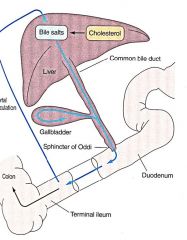
"Enterohepatic recycling occurs Through the liver only part enters thebloodstream, the rest is made more watersolubleby liver enzymes, by a processcalled conjugation, and then the metabolite(conjugate) is excreted in bile. When bilereaches the intestine, bacteria break downthe conjugate releasing the original drugwhich is then reabsorbed, passes in thehepatic portal vein to the liver and aproportion passes into the blood streamwhilst the remainder is reconjugated andexcreted in bile. Overall this prolongs theabsorption of a drug (little by little it entersthe bloodstream." |
|
|
what is half life concenpt and what does it take into account? what is the equation for HL? |
"Half-life is an important concept that takes intoaccount metabolism and excretion of drugs.Half-life = t½ = time for plasma concentration todecrease by 50%. If the half life of a drug is 2hours and its initial concentration is 10microgram per ml of blood, this means that after2 hours its concentration will be 5 microgram perml." |
|
|
Oral doses are usually given at? |
"Oral doses are usually given at intervals of onehalf-life. This means that plasma levels arealways kept ""topped up""." |
|
|
Half life is the major determinant of? |
Half life is the major determinant of dose frequency |
|

Two drugs (X and Y) are given atthe same time intervals. The halflife of drug X is double that ofdrug Y.Thus which drug will accumulateto a greater degree? |
drug X |
|
|
Pharmacodynamics is the study of?
|
"Pharmacodynamics is the study of what the drug does to the body, or more specifically the study of thebiochemical and physiological effects of drugs on living systems and includes therapeuticactions and adverse effects." |
|
|
how do most drugs produce their actions ? |
"Most drugs produce their actions by interacting with specific drugtargets such as receptors or enzymes" |
|
|
what does pharmacodynamics involve? |
Pharmacodynamics involves an agonist and an antagonist |
|
|
what is an agonist? |
"Agonist – Chemicals or drugs that bind to and activate a receptor thus eliciting a response.They have intrinsic activity or efficacy. A partial agonist is said to have less intrinsic activity orefficacy i.e. they do not fully activate the second-messenger system" |
|
|
what is a curare? |
"CurareCurare is a common name for various arrow poisonsoriginating from South America.Curare is an example of a non-depolarizing musclerelaxant that blocks the nicotinic acetylcholine receptor(nAChR), one of the two types of acetylcholine (ACh)recep" |
|
|
what is an Antagonist? |
"Antagonist – Chemicals or drugs that bind to butDO NOT activate a receptor. They have no biologicaleffect or intrinsic activity at the level of the receptor.They do however block or reverse the effect of an agonist" |
|
|
what does a ligand refer to? |
Ligand refers to a key/chemical that fits a particular lock/receptor |
|

what is the following diagram an illustration of? |

"(1) – Competitive antagonistThe curve shown in A is the agonist effectof a drug in the absence of an antagonist.Curve B shows the effect in the presenceof a fixed concentration of an antagonist." |
|
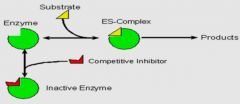
what is the following diagram an illustration of?
|
reersible-competitive antagonist: "Reversible – Competitive• Inhibitor competes with substrate for bindingat active site• Structural analogs of substrate or transitionstate• Increases Km (or decreases affinity)• Can be overcome be increasing substrate" |
|

what is the following diagram an illustration of?
|
(2) Non-competitive antagonistThe curve shown in A is the agonist effect of a drug in the absence of anantagonist.Curve B is the effect in the presence of a fixed concentration of the antagonist.Note: the effect of the antagonist cannot be completed over come at higherconcentrations. Why?
|
|

what is the following diagram an illustration of?
|
"Reversible – Noncompetitive• Does not compete with substrate for activesite• Binds to enzyme and ES• Decreases Vmax• Km usually unchanged as substrate bindingunaffected"
|
|
|
describe in detail a dose response curve |
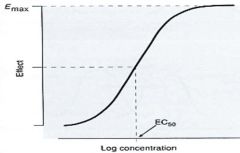
"A dose response curve: Log dose-responsecurves have a sigmoidshape with anapproximately linearregion over 20-80% ofmaximal response.They are widely used tostudy drug action andto work out theconcentration of thedrug used to produce50% of maximalresponse."
|
|
|
what is the molar concentration of agonist required to produce half the maximum response? |
"The molar concentration of agonist required to produce half the maximum responseis the EC50. This is an estimate of potency" |
|
|
what is efficacy? |
Efficacy is the ability of a drug to produce an effect at a receptor |
|
|
what is the defenition of Potency |
"Potency – an estimate ofthe concentration of adrug that will elicit aresponse." |
|

"Which has the greaterpotency Drug A or DrugB?Which drug has thegreater potency Drug Aor Drug C?" |
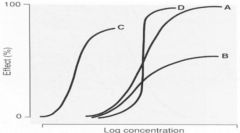
"Drugs “A” and “B” have a similar potency i.e. a similar concentration of the drug produces 50%of the maximum effect.Drug “C” is more potent than either drug “A” or “B”. This means a lower concentration of the drugis needed to produce a similar effect" |
|
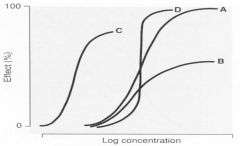
"Drugs A and D havesimilar values for Emaxand EC50.Which drug would besafest one to use? Why?" |
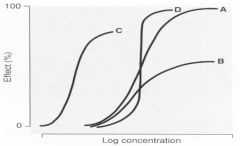
"The shape of the curves is also important. Drugs “A” and “D” have similar values for Emax andEC50 BUT drug “D” has a much steeper curve. This can have important clinical implicationsbecause it means a slight change in the concentration of the drug can produce large changes ineffect. This can be undesirable effects with drug treatment." |
|
|
what is the therapeutic window |
"Therapeutic window = range of plasma drug concentrations between the toxicrange and the ineffective range. If the range is narrow then the drug is said tohave a low therapeutic index." |
|
|
what does a broad therapeutic window mean? |

"A broad therapeutic window means there is awide gap between the desired effect of thedrug and the toxic effects of the same drug" |
|
|
what doesa narrow therapeutic index mean? |
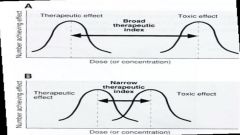
"A narrow therapeutic index means there isa narrow gap between the desired andtoxic effect of a drug" |
|
|
Drugs with a broad therapeutic window are? |
"Drugs with a broad therapeutic window are generally safe and easy to use. eg. PenicillinDrugs with a low therapeutic window are difficult to use and levels are commonly monitored by frequentlymeasuring plasma concentrations" Drugs with a broad therapeutic window are |
|
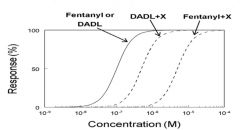
"What is the nature of the interaction between drug A or drug B and Y?A) Y is a non-competitive antagonist of both drug A and drug BB) Y is a non-competitive agonist of both drug A and drug BC) Y is a competitive agonist of both drug A and drug BD) Y is a competitive antagonist of both drug A and drug BE) Y is a irreversible competitive antagonist of both drug A and drug B" |
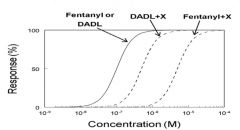
D - Y is a competitive antagonist of both drug A and drug B |

